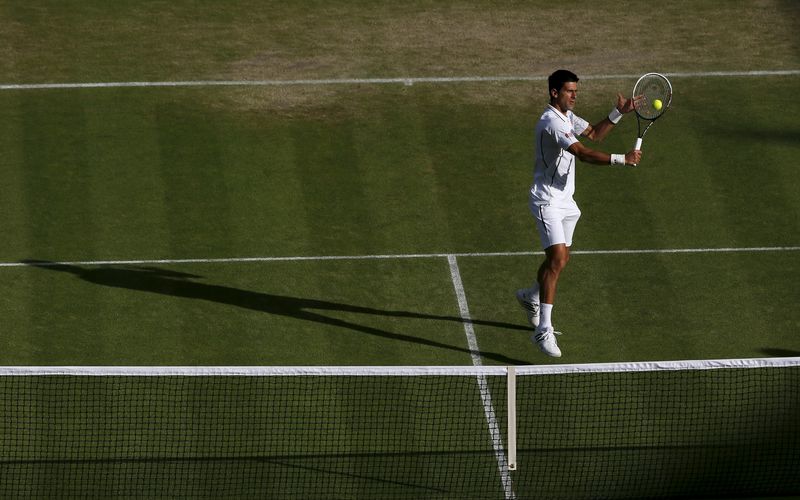By Ossian Shine
LONDON (Reuters) - The yellowing obituaries are looking premature as serve-and-volley tennis creeps, with a few tweaks, toward a renaissance of sorts.
A number of top men are leading the charge and, in a curious twist, the same blend of technology and lung-busting fitness blamed for all-but killing off this style of play is behind its resurgence.
As players hit harder shots, miss fewer balls and run for hour upon hour, competitors need a ploy to shorten points.
Introducing... the serve-and-volley.
It is an old-school move which, used selectively, might just become the newest potent weapon in the armory of modern players.
"At the moment you see the guys winning the slams from the baseline," former tour pro and leading coach and tennis analyst Darren Cahill told Reuters.
"But then you see the great players of today working on their net games because they know it saves them physically because they have to work so hard to win points.
"Over the course of a grand slam, seven matches, best of five, they are looking at ways to shorten points to save as much energy as they can.
"I think Novak, Rafa and Roger are coming in way more than they were four or five years ago," Cahill said of Djokovic, Nadal and Federer.
Time was that unless you knew the dark arts of serve-and-volley, you could forget about winning Wimbledon.
Even baseliner Bjorn Borg would roll his rounded shoulders into the ball and race to the net at the All England Club, punching his wooden racket through the white ball.
Not as frequently as John McEnroe, of course, who elevated serve-volley to a higher art form -- nor the likes of Pat Cash, Boris Becker and Pete Sampras who followed him.
But, all the same, Borg knew his way around the net -- a fact mostly overlooked because his baseline play was so preternatural.
EVERYTHING CHANGED
Over the years it became received wisdom that grass, plus serve, plus volley, equals silverware. It was a simple equation which had served dozens and dozens of champions down the years.
Then everything changed.
Racquets got bigger, lighter, more powerful.
Players got fitter, balls got lighter and grass courts -- in a bid to recreate the longer rallies killed off by the super-powerful equipment -- got slower.
Different grass of different lengths was experimented with. The balance of baseline tennis and serve-and-volley tennis tipped.
In 2002 Lleyton Hewitt squared up to David Nalbandian in the first Wimbledon men's final contested by two baseliners.
Hewitt won a forgettable affair during which neither player attempted to serve-volley. Not one point.
Now that Wimbledon could be won with a big forehand and even bigger lungs, the motivation to learn and hone the art of net play, and serve-volley in particular, receded further.
The new racquets and strings allowed players to strike a ball down by their ankles with a full-blooded swing and send it flying low and dipping over the net -- a volleyer's worst nightmare.
A few cavalier souls persevered but, generally, the baseline pattern was set. Federer eased into all-court excellence, while Nadal and Djokovic mopped up grand slam crowns with baseline crunching shots.
Some skeptics said it was a cycle. Serve-volleying titans, including McEnroe and Tony Roche, imagined a time when a super-athlete emerged and breathed new life into the old tactic.
That has not happened yet. But slowly, the skill of hustling into the net immediately behind a serve is growing in popularity -- often on second serve where more spin and kick allows more time for the volleyer to get in place.
DECADES IN THE WILDERNESS
The tactic is becoming common on clay courts as a way to finish a point quickly, and it possesses the element of surprise after decades in the wilderness.
Andy Murray's coach Jonas Bjorkman, in his day a serve-volleyer, says he wants the Briton to use the tactic more.
Three-times Wimbledon champion Boris Becker, perhaps the most aggressive serve-volleyer of them all, wants his charge, world number one Djokovic, to give it a whirl.
Federer, now coached by another exponent of the art Stefan Edberg, best illustrates the trend. In 2002 he serve-volleyed more than 80 percent of the time at Wimbledon.
By 2003 that figure had dropped to 3.5 percent according to the tournament's official statisticians IBM (NYSE:IBM).
A gradual increase then kicks in, with the Swiss upping his serve-volleying year-on-year to more than 20 percent in 2014.
Djokovic used the tactic to good effect in Paris at the French Open last month where he lost in the final.
Although nobody predicts a return to the tennis of 30 years ago, this year's Wimbledon statistics will make for interesting reading.

"I think anyone who does serve and volley well is going to have some success... it's different to what players are used to," Cahill said.